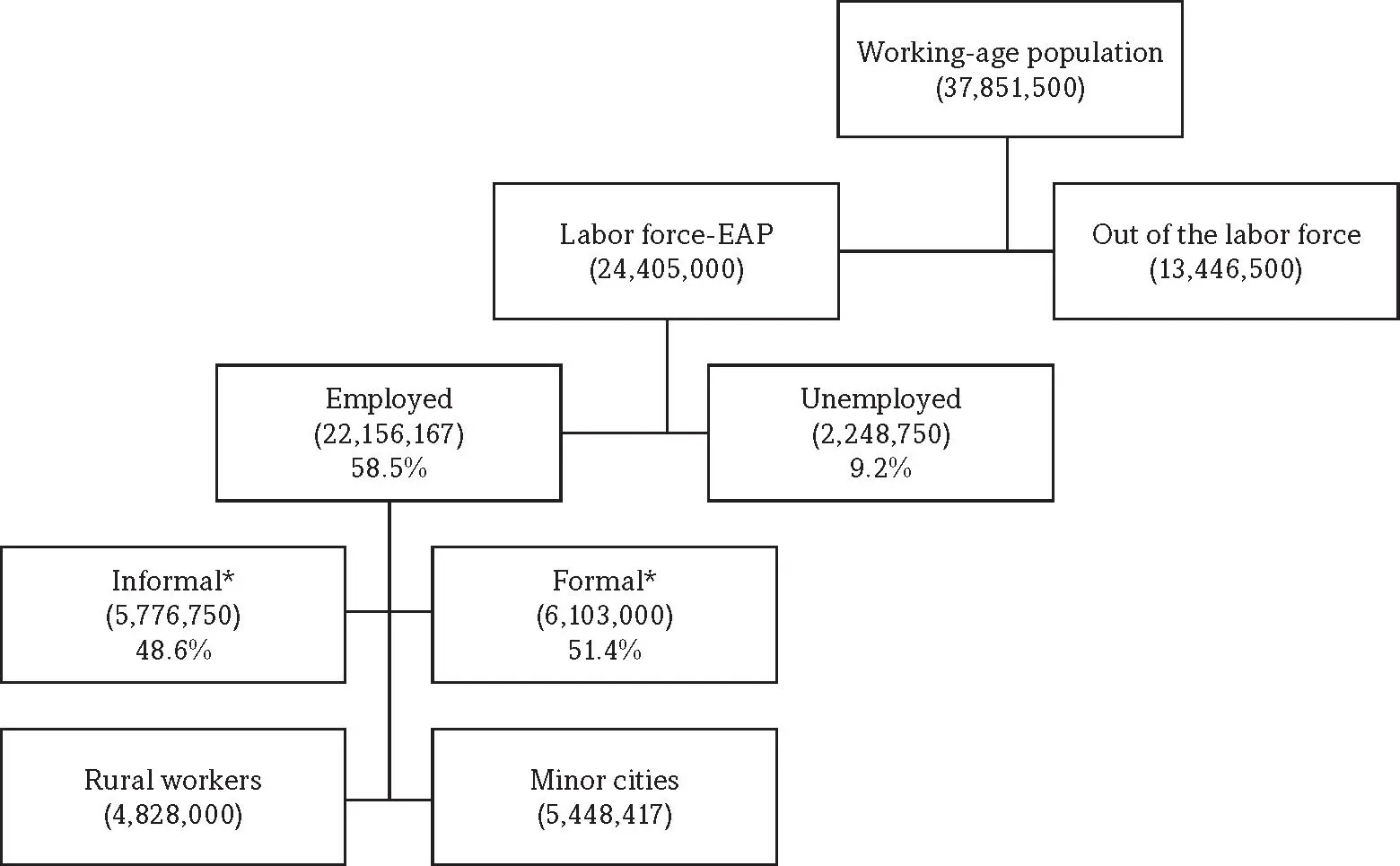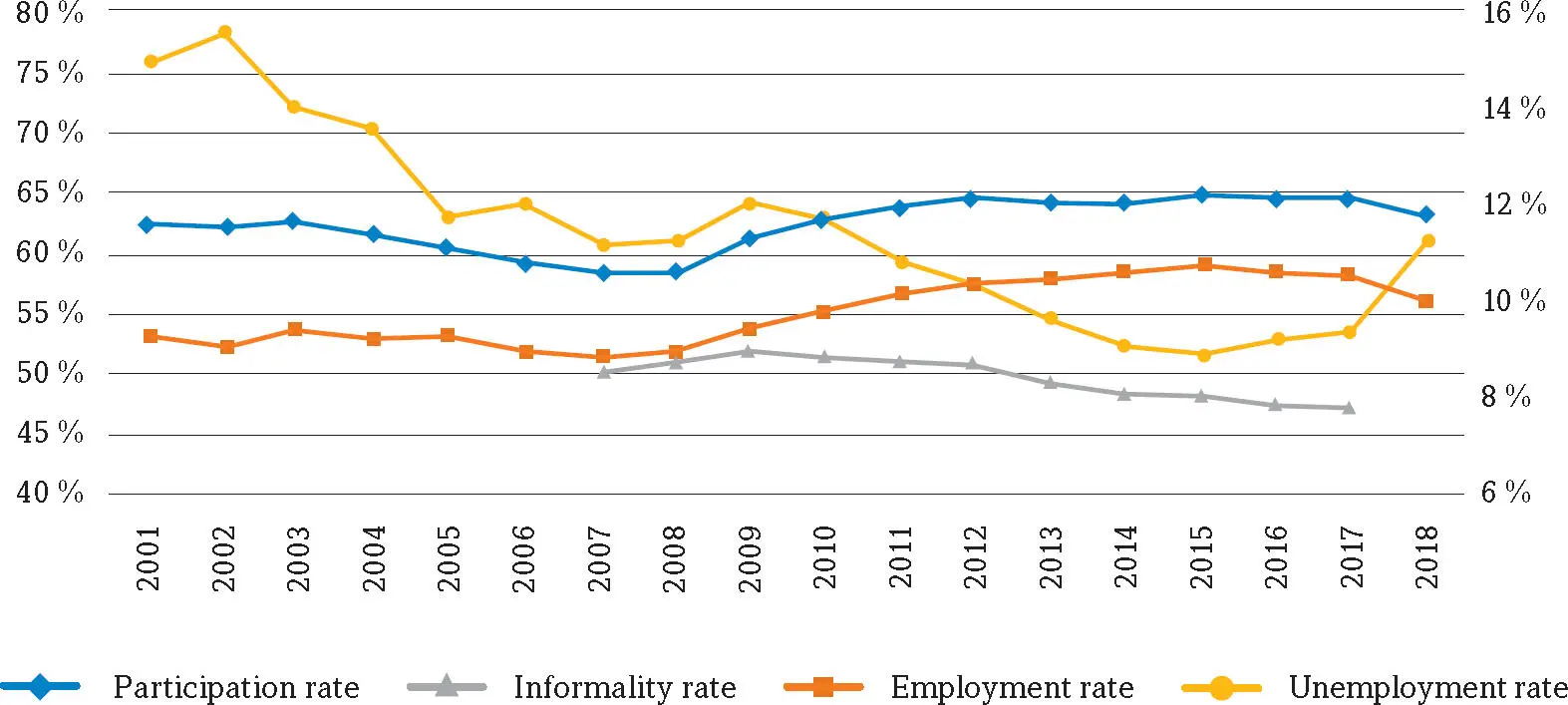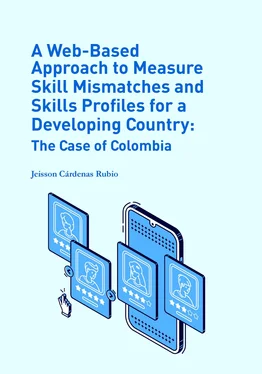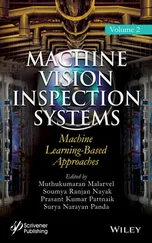Due to their importance and multiple dimensions (e.g. qualifications, competences, education, aptitudes, etc.), skills can be defined in different ways; nevertheless, most of those definitions link the task complexity of each job to the characteristics that each worker needs in order to successfully carry out these job tasks. For this reason, this book considers that a skill is any measurable quality that increases worker productivity and can be improved by training and/or development. Using this definition, it is possible to analyse and extract information on vacancies to construct more reliable indicators of the skill level required by employers (e.g. qualifications), as well as to address possible skill mismatch issues.
Under perfect competition, the over- or undersupply of skills (skill mismatches) only arise in the short term and have relatively small implications for unemployment and informality rates (exclusion). However, the conditions required for perfect competition rarely exist because agents have imperfect information about offered and demanded skills. This imperfection in the labour market might create a situation where there is a lack of skills in relation to what employers currently require in order to fill their vacancies: a skill shortage. Skill shortages might create labour market segmentation where workers with the “right” skills have more probabilities to belong to the formal economy, while workers without the “right” skills (according to demand) have more chances of being in the informal economy or unemployed. Consequently, unemployment and informal economy might increase and/or persist over time.
The above skill mismatch problem involves the coordinated actions of at least three different agents in the economy: employers, workers, and education and VET systems. The level of coordination between these three groups determines the extent of skill mismatch. This coordination depends on the availability of information about skill requirements and the capability of workers to process and adopt that information into their decisions, as well as the availability of education and training systems.
In this sense, one way to tackle the skill mismatch phenomenon is to gather information about labour demand, and to extract meaningful information in order to address the decisions of workers and education and VET systems, according to different company requirements. New technological developments offer new opportunities in this respect. This particular theoretical framework and straightforward solution might be especially useful for countries like Colombia where: 1) informality and unemployment rates are high, 2) complaints about skill shortages (skill mismatch) are relatively high, 3) information about company requirements is available from resources such as job portals, and 4) education and VET institutions have difficulties to adapt their programs according to labour demand.
For these reasons, the next two chapters demonstrate that in the context of the Colombian economy, novel sources of information and data analysis regarding the labour demand for skills might have an important effect on public policy and could reduce unemployment and informal economy at a lower cost in terms of time and monetary sources.
3. The Colombian Context

3.1. Introduction
Skill mismatches are a widespread phenomenon that have strong implications on unemployment and informality rates, among other variables (McGuinness and Pouliakas 2016) (see Chapter 2). Nevertheless, some countries display a higher incidence of these issues, which might have severe effects on local labour outcomes. This chapter presents evidence that Colombia is a country where the degree of skill mismatches (skill shortages), unemployment, and informality is relatively high. However, public policies that tackle those outcomes are limited, and, consequently, this makes Colombia a relevant case of study to develop novel ways to analyse and reduce skill mismatches.
Based on the concepts discussed in Chapter 2, this chapter, first, provides an overview of the main characteristics of the Colombian labour market and its evolution over time. Second, it shows that the issue of skill mismatches and their possible incidences have a relatively high impact on the national economy, which needs to be addressed by public policies. Subsequently, it explains the importance of maintaining systems with accurate labour market information to address these phenomena. Finally, it is argued that the lack of information about skill requirements, together with an institutional disarticulation, especially in Colombia (and other developing countries), makes it difficult to develop well-orientated public employment policies to deal with the skill shortage phenomenon. For this reason, there is a need to find novel solutions to systematically provide accurate information and analyse employer requirements and possible skill mismatches.
3.2. The characteristics of the Colombian labour market
This section describes the main characteristics of the Colombian workforce and labour demand in order to present the structure of one of the most relevant labour market issues Colombia has been facing: unemployment and informality.
3.2.1. Labour supply
Figure 3.1shows the structure of labour supply in Colombia at a macroeconomic level. In 2016, the Colombian working-age population was composed of around 37,851,500 people, of which 64.4% participate in the labour market (approximately 24,405,000 people), representing the current labour supply in Colombia. As mentioned in Chapter 2, labour supply is composed of: 1) people in the working-age population who do not have a job but are looking for one (unemployed), and 2) people who are in the working-age population and are hired by employers (employed), and who are self-employed. As shown in Figure 3.1, around 90.7% of the economically active population (EAP) have a job (employed); however, 5,776,750 people work in informal jobs. In addition, around 9.2% of the Colombian workforce is unemployed.
These indicators highlight a key point: in Colombia, the labour participation rate is relatively high. Indeed, it is 2.6 percentage points above the Latin American average (ILO 2016b, p. 29). However, only 51.4% of the employed population has a formal job ( Figure 3.1). Moreover, high unemployment and informality rates are persistent in Colombia. As shown in Figure 3.2, in 2001, 27the annual national unemployment rate was approximately 15%, while the participation rate was 62.4%. In the same period, the informality rate decreased from 50.4% in 2006 28to 47.5% in 2016 (DANE 2017a). This result means that during the last fifteen years more people have participated in the Colombian labour market. Formal labour demand has absorbed a considerable proportion of labour supply to the point that unemployment and informality rates have declined, even with more people participating in the labour market.
Figure 3.1. Labour structure in Colombia

Source: Author’s calculations based on DANE 2017a.
*Informality is only calculated for urban areas. As explained in Chapter 2, for rural areas, the definition of informality (company size) is not accurate. At the time this chapter was written, there was no official measure of informality for those rural areas.
Figure 3.2. Participation, employment, unemployment, and informality rate trends, 2001-2018

Source: DANE 2017a.
Читать дальше















